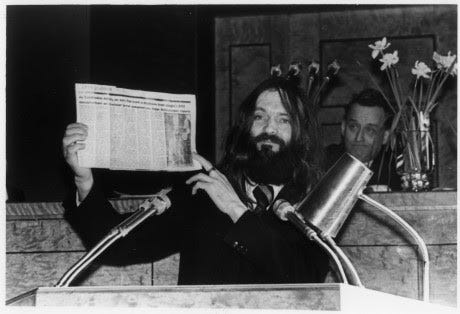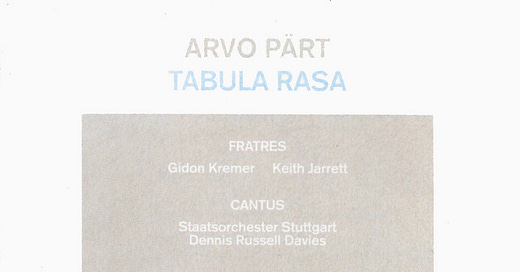Genre of the Day - Holy Minimalism
Album of the Day - Arvo Pärt: Tabula Rasa by Arvo Pärt (1984)
Holier-than-thou minimalism seems to be everywhere. It’s in the parents of the sad beige babies, the visual dryness of sage green that abounded these past few years, all-white kitchen remodels, the stark color choices of new builds in any trendy city. A brief scan of Interior Design’s homepage revealed only one design spotlight on the main page with a colorful spread, dubbed ‘zany’ by the headline. Fortunately for us, today’s genre has no connection to these dispirited palette movements. Holy minimalism is the sound of the 20th-century minimalist movement in classical music being spritzed with a douse of holy water, exploring what the sanctity of religious music could bring to minimal compositions.
Serialism was my first true sonic shock on this column, popping up three days into the year. It was my introduction into a vernacular of wild, methodical approaches to music, otherworldly and incomprehensible. Holy minimalism represents a new chapter of 20th-century classical thought—still scrupulous and methodical, but without such inaccessible droning complication. With the intellectual rise of agnosticism in modernist thought, hundreds of years of European musical tradition steeped in the foyers of the church had fallen by the wayside in classical music composition. A few crate-digging composers in the 1970s like Henryk Górecki, Arvo Pärt, and John Tavener, found themselves tired of the reign of Schoenberg-esque avant garde ghastliness, preferring the tonalist works like those of Phillip Glass. They set their sights on Christian music’s historical genius in evoking religious wonder and enthralling beauty, from polyphony to Gregorian chant.
Though it would revitalize minimalist classical music’s image among the concert-going public and today’s artist went on to become something of a celebrity composer, the term “holy minimalism” was initially pejorative. Critics fired off at the anachronistic notion that postmodern minimalism could capture the depth of traditional liturgical music. Through innovative musical languages all his own, Arvo Pärt took risks that would not only disprove such critics, but find him staring down the barrel of the USSR’s cultural gun.
Estonian-born Arvo Pärt captured the essence of his sacred inspirations with a trailblazing spirit cracking open the cage of modernist techniques he’d felt repressed him. Having already established himself as a composer of distinction in the USSR, his religious turns were not welcomed in an environment of state atheism, precipitating a move to Vienna in 1980. Nonetheless, he went forth with his bold manifesto in an adorable term he coined—tintinnabulation. It constituted a compositional language, music theory nerd’s potential hyperfixation, and personal philosophy. Arvo Pärt interpreted triads as the sound of little bells, their perfect harmonies capturing the religious serenity he sought to communicate through music as awe-striking and reflective as it was compositionally (relatively) simple. Tintinnabuli weaves together two melodic voices—a triad arpeggio and ascending or descending scalar melody. It’s counterpoint, simply informed by a trinity not unlike the Holy Trinity central to Orthodox Christian theology.

Today’s set, featuring the two-part composition “Tabula Rasa” as well as two other key works by the composer, introduces us to Pärt’s vision of musical eternity through trinity. Beginning with the drawn-out strings of “Fratres” performed by a single violin and piano, the alternating sharpness of strings and low, stolid piano notes seem to reflect the flow of moments of epiphany and grounding guidance experienced during a long prayer. “Cantus in Memory of Benjamin Britten” mourns one of his inspirations; its descending, rich gusts are gripping with anguish before slowing into quiet respite at the end. “Tabula Rasa” is near-lively with its frantic string outbursts, with a clear focus on exploring tintabbuli’s particular emphasis on striking melodic ascents and descents. Holy minimalism is far from holier-than-thou—it’s an approach that balances systematic, austere visions of music while teasing out emotions with far more grace as a result of its spiritual leaning. This is no sad beige baby music, and I’ll end with a quote from Pärt himself that tells you as much.
"I could compare my music to white light, which contains all colors. Only a prism can divide the colors and make them appear; this prism could be the spirit of the listener."
It is our restless human spirits and interpretations that help render music colorful and gorgeous, sonic light shining through our souls’ stained glass windows.




